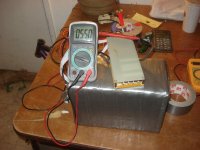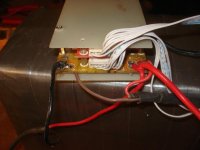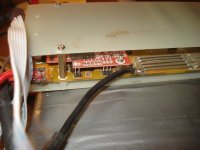They're virtually identical; the actual cell batch appears to be the only physical difference I can identify, beyond the different connectors on each of them, and the fact that the Volgood's negative charging wire goes to the pack negative on the BMS, and the Vpower's goes to the discharge negative.
The only consequence of that is that the Vpower could theoretically cut off charge (or regen) if the voltage went too high, assumign the BMS has an HVC (I don't know), and the Volgood could not.
I think there might be something slightly different in either the BMS or in the cells, regarding reverse current (regen), because there is a different "feel" to regen braking with the Volgood, even at what seems the same voltage. I suspect that the Volgood pack or BMS or connectors are slightly higher resistance, so the voltage drop across it is higher under regen/charging, and so it generates less current for the same voltage across it.
It is a very slight difference, enough that it might even be my imagination (but I don't think so).
It isn't that important, so I will probably not satisfy my curiosity by soldering on my own Anderson MP (SB50) connector to the BMS in addition to your existing output plug, and try each one on the same ride during braking tests. But I considered it.
EDIT: Speaking of connectors and resistances, I *did* go ahead and solder the splice on the negative pack wire to the BMS, and heatshrink it, as well as soldering the positive pack wire to the BMS pad for that, because the tape over the unsoldered but zip-tied splies was coming loose (perhaps from the heat here?) and I was afraid of a short at some point. The Vpower has a connector to the pack from the BMS, but the Volgood is wired directly to the BMS. Either works, and actually the direct wiring should be better and lower resistance (and less failure prone).
I expect that capacity-wise theyr'e different, due to different ages and different cell batches and cell conditions, but I don't yet know which is "better", until capacity-in-use tests are complete.
Other than that, they're close enough to the same that I couldn't pick them out of a lineup.
The only consequence of that is that the Vpower could theoretically cut off charge (or regen) if the voltage went too high, assumign the BMS has an HVC (I don't know), and the Volgood could not.
I think there might be something slightly different in either the BMS or in the cells, regarding reverse current (regen), because there is a different "feel" to regen braking with the Volgood, even at what seems the same voltage. I suspect that the Volgood pack or BMS or connectors are slightly higher resistance, so the voltage drop across it is higher under regen/charging, and so it generates less current for the same voltage across it.
It is a very slight difference, enough that it might even be my imagination (but I don't think so).
It isn't that important, so I will probably not satisfy my curiosity by soldering on my own Anderson MP (SB50) connector to the BMS in addition to your existing output plug, and try each one on the same ride during braking tests. But I considered it.
EDIT: Speaking of connectors and resistances, I *did* go ahead and solder the splice on the negative pack wire to the BMS, and heatshrink it, as well as soldering the positive pack wire to the BMS pad for that, because the tape over the unsoldered but zip-tied splies was coming loose (perhaps from the heat here?) and I was afraid of a short at some point. The Vpower has a connector to the pack from the BMS, but the Volgood is wired directly to the BMS. Either works, and actually the direct wiring should be better and lower resistance (and less failure prone).
I expect that capacity-wise theyr'e different, due to different ages and different cell batches and cell conditions, but I don't yet know which is "better", until capacity-in-use tests are complete.
Other than that, they're close enough to the same that I couldn't pick them out of a lineup.




